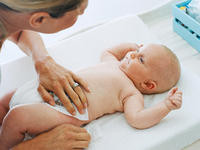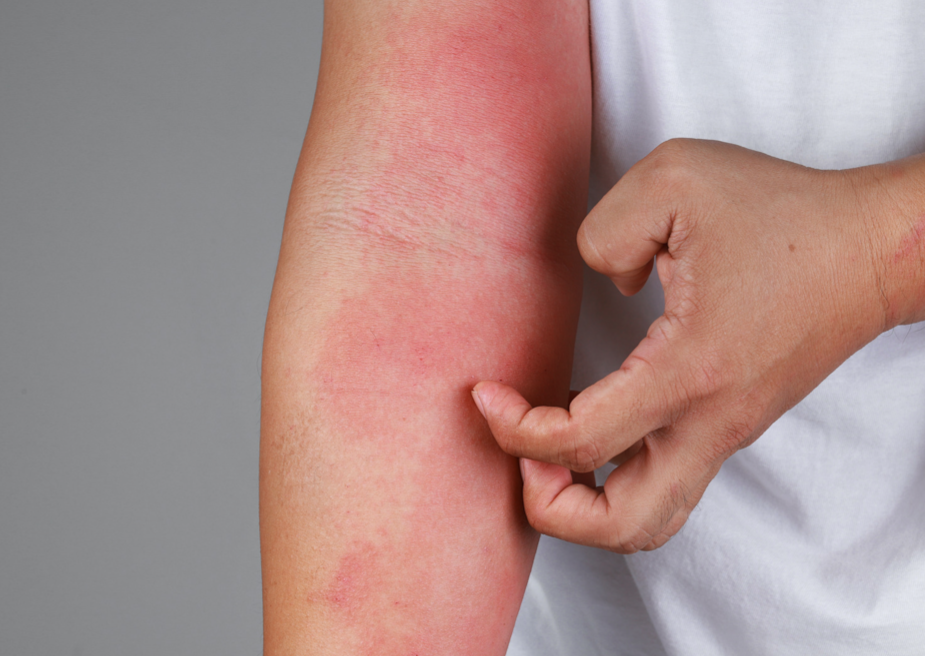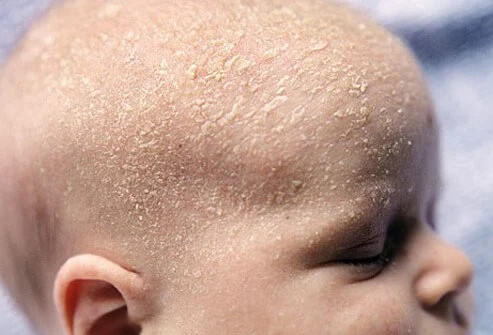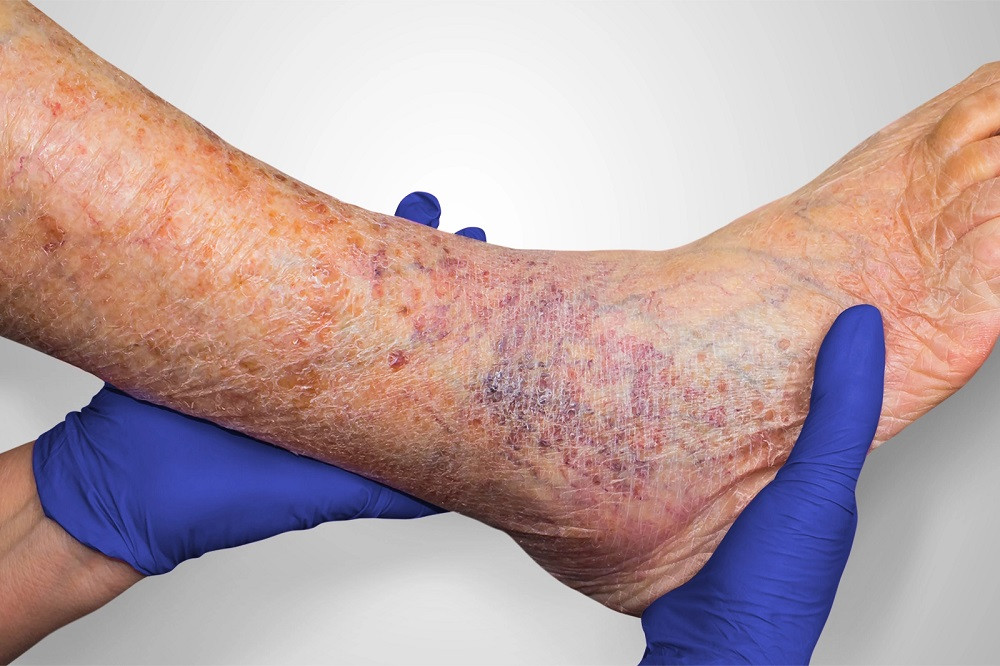Definisi
Ruam popok merupakan bentuk umum peradangan kulit (dermatitis) pada bayi dimana kulit tampak kemerahan di area bokong akibat penggunaan popok dan umumnya terjadi pada bayi yang berusia 4 hingga 15 bulan. Ruam popok sering dikaitkan akibat popok yang basah, penggantian popok yang terlalu lama, kulit sensitif, dan adanya luka lecet pada daerah bokong. Ruam popok juga dapat disebabkan infeksi jamur, paparan terhadap feses atau urine bayi, dan penggunaan popok terlalu ketat sehingga dapat menggesek kulit.
Ruam popok dapat menyebabkan orang tua khawatir dan ketidaknyamanan pada bayi, bayi dapat menjadi rewel akibat adanya ruam. Namun ruam popok tidak berbahaya, ruam ini dapat diobati dengan perawatan di rumah. Tetapi terdapat beberapa kondisi dimana ruam popok perlu pengobatan dokter.
Penyebab
Ruam popok dapat disebabkan oleh beberapa hal atau kondisi tertentu, contohnya:
- Iritasi akibat kontak dengan feses dan urine. Kontak feses dan urine dengan area popok yang berlangsung lama dapat menyebabkan kulit bayi yang sensitif mengalami iritasi sehingga dapat menyebabkan ruam popok. Kondisi diare atau mencret pada bayi dapat menyebabkan ruam popok karena feses lebih bersifat iritasi dibandingkan dengan urine.
- Popok yang terlalu ketat sehingga kulit mudah terkena gesekan. Popok yang terlalu ketat dengan area kulit dapat menyebabkan gesekan yang berulang. Gesekan yang berulang dapat menyebabkan kerusakan pada pertahanan kulit di area bokong dan akhirnya dapat menimbulkan ruam popok.
- Iritasi dari produk pembersih popok (baby wipes). Produk pembersih popok bayi (baby wipes) yang mengandung alcohol dan parfum dapat menyebabkan gangguan pada kulit yang tertutupi oleh popok sehingga ruam popok dapat terjadi pada bayi Anda.
- Infeksi bakteri atau jamur. Ruam popok dapat diakibatkan oleh infeksi jamur yang disebut sebagai infeksi candida yang umumnya terjadi pada anak. Jamur candida tumbuh dengan baik di area yang hangat dan lembap seperti di area pemakaian popok. Umumnya ruam popok akibat infeksi jamur candida cenderung terjadi pada bayi-bayi yang memiliki kondisi area popok yang tidak bersih dan kering.
- Pengenalan makanan baru. Pengenalan makanan saat bayi Anda memulai makan makanan padat akan menyebabkan perubahan pada feses. Kondisi ini dapat menyebabkan ruam popok.
- Kulit yang sensitif. Bayi yang memiliki kulit sensitif rentan sekali untuk mengalami ruam popok
- Penggunaan antibiotik tertentu. Penggunaan antibiotik dapat membunuh mikroba baik atau jahat yang ada. Saat bayi Anda mengonsumsi antibiotik, infeksi jamur dapat berkembang lebih pesat akibat bakteri baik yang ada di area popok terbunuh oleh antibiotik sehingga ruam popok dapat terjadi.
Faktor Risiko
Pengenalan mengenai beberapa faktor risiko sangat berperan penting dalam pencegahan hingga pengobatan ruam popok. Semua bayi dapat berisiko mengalami ruam popok. Namun, ada beberapa faktor risiko yang menyebabkan bayi atau anak-anak menjadi lebih rentan mengalami ruam popok.
Beberapa faktor risiko diantaranya:
- Usia. Pada bayi baru lahir dan bayi memiliki kulit yang masih cukup sensitif sehingga meningkatkan risiko terjadinya ruam popok.
- Pola makan atau diet. pola makan yang berubah saat bayi bertumbuh memilki hubungan dengan perubahan susunan mikroba di usus dan pH feses sehingga memungkinkan terjadinya ruam popok.
- Frekuensi penggantian popok. Kontak yang berlangsung lama dengan iritan seperti feses dan urine meningkatkan risiko terjadinya peradangan kulit pada area pemakaian popok. Bayi baru lahir yang sering digantikan popoknya cenderung memiliki risiko lebih rendah terkena ruam popok.
Gejala
Beberapa gejala dan tanda yang dapat muncul pada area popok bayi Anda adalah:
- Tampak bercak merah terang yang memungkinkan semakin besar dan melebar
- Tampak bercak merah dan bersisik pada area pemakaian popok, seperti area skrotum dan penis pada bayi laki-laki atau labia dan vagina pada bayi perempuan
- Bintil, lenting, luka, atau nanah dapat muncul pada ruam popok yang disertai dengan adanya infeksi bakteri
Diagnosis
Diagnosis ruam popok merupakan diagnosis klinis, artinya dokter dapat menetapkan diagnosis ruam popok melalui wawancara medis khusus dan pemeriksaan fisik pada umumnya melalui penampakan adanya ruam merah pada area kulit yang tertutupi oleh penggunaan popok. Meskipun demikian, ada beberapa pemeriksaan penunjang yang dapat membantu seorang dokter untuk menetapkan diagnosis pasti hingga kemungkinan komplikasi yang dapat muncul.
Beberapa pemeriksaan penunjang biasanya diperlukan untuk mengetahui penyebab yang mendasari terjadinya ruam popok, diantaranya pemeriksaan mikroskopik tertentu, seperti pemeriksaan kerokan kulit.
Tata Laksana
Prinsip tata laksana pada kasus ruam popok adalah menjaga kulit area popok bersih dan tetap kering. Hal ini juga berguna untuk mencegah berulangnya kasus ruam popok. Apabila memungkinkan, alaskan area kulit popok bayi dengan handuk tanpa ditutupi popok.
Beberapa langkah yang dapat dilakukan di rumah apabila ruam popok muncul adalah menjaga area popok tetap bersih dan kering dengan mengganti popok sesegera mungkin sesaat setelah popok menjadi basah akibat buang air besar atau buang air kecil. Setelah membersihkan area popok dengan baik dan kering, boleh diberikan krim atau salep yang memiliki kandungan zink oksida dan petroleum jelly.
Selain itu, untuk membantu mempercepat proses penyembuhan dari ruam popok, lakukan hal yang bisa dikerjakan untuk meningkatkan paparan udara pada area popok, misalnya membiarkan kulit area popok tanpa ditutupi popok selama sekitar 10 menit dan lakukan hal ini sebanyak tiga kali sehari. Lalu, hindari popok yang terlalu ketat. Gunakan popok yang lebih besar dari ukuran biasanya hingga ruam popok menghilang. Apabila ruam popok tetap terjadi, dokter mungkin akan memberikan beberapa obat oles seperti krim steroid atau krim antijamur untuk mengobati ruam popoknya.
Komplikasi
Komplikasi yang dapat muncul pada kasus ruam popok adalah adanya keterlibatan infeksi bakteri atau jamur. Pertimbangan khusus perlu dilakukan apabila infeksi terjadi pada pasien dengan sistem pertahanan tubuh yang rendah karena berisiko menyebar lebih luas, misalnya pasien dengan pengobatan kemoterapi atau pascatransplantasi organ.
Pencegahan
Setelah mengenali beberapa faktor risiko yang anda miliki, langkah berikutnya adalah perbaikan faktor risiko yang dapat diperbaiki. Berikut langkah-langkah yang dapat anda lakukan:
- Bersihkan bokong bayi Anda dengan air selama setiap ganti popok lalu dikeringkan dengan handuk dengan lembut
- Hindari penggunaan pembersih area popok yang mengandung alcohol atau parfum
- Pakai popok yang longgar dan tidak terlalu ketat pada area kulit popok
- Gunakan zink oksida dan petroleum jelly apabila terdapat ruam popok sebagai tata laksana sementara yang dilakukan di rumah
Kapan Harus ke Dokter?
Jika ruam popok semakin berat atau tidak menghilang dalam 2-3 hari, ruam popok menyebar hingga ke area perut, punggung, lengan atau wajah, ruam popok disertai adanya bintil, lenting, luka, atau nanah, bayi Anda mengalami demam, atau bayi Anda mengalami ruam popok selama 6 minggu pertama setelah lahir, sebaiknya Anda memeriksakan bayi Anda lebih lanjut ke dokter spesialis kulit dan kelamin (Sp.KK) atau spesialis dermatologi dan venerologi (Sp.DV). Dokter akan melakukan wawancara medis, pemeriksaan fisik, hingga pemeriksaan penunjang tertentu untuk menetapkan diagnosis pasti dan tata laksana yang tepat.
- dr Nadia Opmalina
Benitez Ojeda AB, Mendez MD. Diaper Dermatitis. [Updated 2022 March 15]. In: StatPearls [Internet]. Treasure Island (FL): StatPearls Publishing; 2022 Jan-. Available from: https://www.ncbi.nlm.nih.gov/books/NBK559067/
Medline Plus. Diaper rash. August 2021. https://medlineplus.gov/ency/article/000964.htm
Mayo Clinic. Diaper rash. June 2022. https://www.mayoclinic.org/diseases-conditions/diaper-rash/symptoms-causes/syc-20371636
Mayo Clinic. Diaper rash. June 2022. https://www.mayoclinic.org/diseases-conditions/diaper-rash/diagnosis-treatment/drc-20371641
Healthline. Diaper rash. February 2020. https://www.healthline.com/health/diaper-rash












